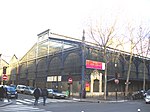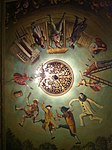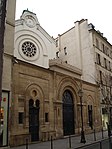Square du Temple
3rd arrondissement of Paris4th arrondissement of ParisBuildings and structures completed in the 13th centuryBuildings and structures demolished in 1810Castles in Île-de-France ... and 3 more
Defunct prisons in ParisFormer buildings and structures in ParisFrench Revolution

The Square du Temple is a garden in Paris, France in the 3rd arrondissement, established in 1857. It is one of 24 city squares planned and created by Georges-Eugène Haussmann and Jean-Charles Adolphe Alphand. The Square occupies the site of a medieval fortress in Paris, built by the Knights Templar. Parts of the fortress were later used as a prison during the French Revolution, and then demolished by the mid-19th century.
Excerpt from the Wikipedia article Square du Temple (License: CC BY-SA 3.0, Authors, Images).Square du Temple
Rue Dupetit-Thouars, Paris 3rd Arrondissement (Paris)
Geographical coordinates (GPS) Address Nearby Places Show on map
Geographical coordinates (GPS)
| Latitude | Longitude |
|---|---|
| N 48.865277777778 ° | E 2.3622222222222 ° |
Address
Rue Dupetit-Thouars 10
75003 Paris, 3rd Arrondissement (Paris)
Ile-de-France, France
Open on Google Maps









